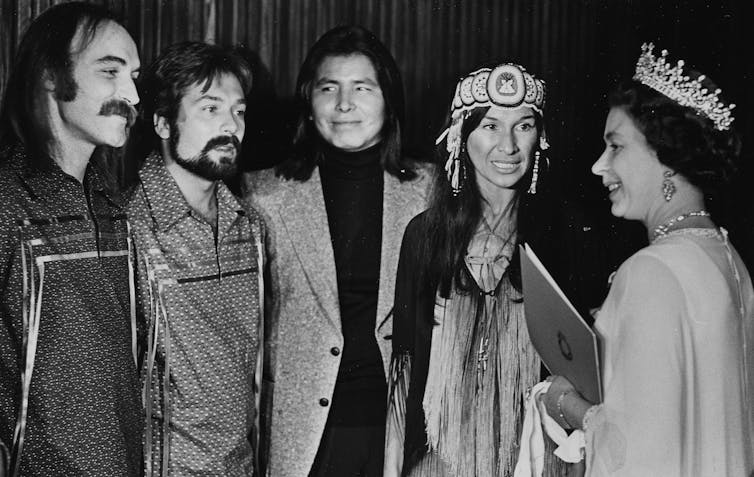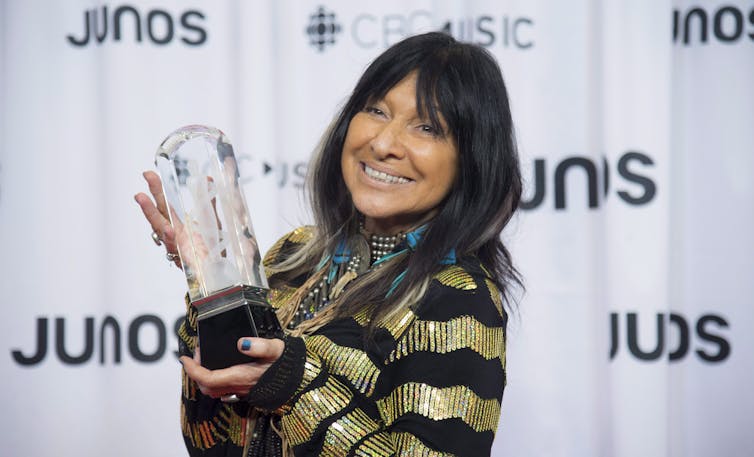This isn’t a story about whether Buffy Sainte-Marie — musical icon, activist, community member and beloved Auntie — is biologically Indigenous. Rather, it’s more important to understand the deep impact a CBC report casting doubts on the singer’s ancestry is having across Indigenous lands — and how the fallout from the report shows what reconciliation is not.
But before I go there, allow me to situate myself. It will shed some light about why this story may not sound like the one you are looking for — like most Indigenous peoples, I still need time to digest this news about Buffy — but why the impact of the story is something non-Indigenous people need to hear.
I am a Two-Spirit iskwew. I am the granddaughter of an Indian Residential School survivor and have lived experienced as a ‘60s Scoop survivor. I always knew I was Indigenous, but I didn’t always know where I came from or who claimed me.
Three decades ago, I began the search to find me. Over the course of 25 years, I managed to locate my birth mother, members of my immediate and extended family, as well as all six of my living siblings who were spread across several provinces.
Searching for identities
I am Cree-Métis. According to colonial systems of citizenship, I have the necessary lineage to be a member of the Métis Nation of Saskatchewan.
Through a 1985 amendment to the Indian Act, Bill C-31, under section 6(1) my grandmother — who originally lost her Indian Status because she married a non-status Indigenous man — was able to regain her status. Thus, my birth mother, and all seven of her children, including me, can gain status under section 6(2) of the act.
The systems do not allow anyone to hold both Métis and Indian Status at the same time. So, we must make a choice. I am a registered status Indian and have membership at Montréal Lake Cree First Nation, the nation of my grandmother.

My story is only one of the hundreds of thousands of Indigenous people’s stories across Canada. Like their stories, mine is complex and confusing. It is triggering and traumatizing. There is joy and there is pain.
Now, let me tell you what reconciliation is not. It is not about sensationalizing or showing insensitivity to the Indigenous experiences in Canada. If learning about truths and your plan of taking steps to put things right causes harm to Indigenous peoples, you need to ask yourself if you are committed to being a real ally or simply performing allyship to advance your own agenda.
Casting doubts about an icon
On Oct. 27, CBC News published a lengthy investigative article with the sensationalist headline “Who is the real Buffy Sainte-Marie?” The article was based on a documentary called “Making an Icon” by the network’s Fifth Estate program that casts doubts on Sainte-Marie’s claim of Indigenous ancestry.
There are very few Indigenous peoples who have reached the stardom that Buffy Sainte-Marie has attained over her career. Because of this, she has been an inspiration to generations of Indigenous peoples.
Her fame and success made many of us believe that our goals and aspirations were possible at a time when there was very little representation for Indigenous folks like us. Over her career, many Indigenous peoples, communities and families built reciprocal relationships with Buffy — in particular, members of Piapot First Nation in Saskatchewan.
No warning, no sensitivity
Suddenly, this story broke and everything we believed about her was called into question. There was no warning and no sensitivity to the impact it would have on Indigenous peoples. This is not how reconciliation is done.
The role of the media was not left out of the Truth and Reconciliation Calls to Action. Call to Action 84(iii) speaks directly to CBC — Canada’s national public broadcaster — to support reconciliation by ensuring its coverage considers Indigenous “history and legacy of residential schools and the reconciliation process.”
Since this story broke, I have read Indigenous expressions of hurt, trauma, pain, betrayal and disbelief as I scroll through my social media.
I ask the CBC: How are you supporting Indigenous peoples as our families and communities deal with the impact of your story? How is this reconciliation?
Read more: How journalists tell Buffy Sainte-Marie’s story matters — explained by a ’60s Scoop survivor
The Truth and Reconciliation Commission’s Call to Action 86 says Canadian journalism programs should ensure all journalists are educated about Indigenous laws. The CBC report’s lack of recognition for the significance and meaning of First Nation’s traditional adoption practices was shameful, and the impact this oversight had is dishonourable.
A key part of the CBC report casts doubts on the singer’s own explanation of her Indigenous roots — that she was born to an Indigenous mother on the Piapot Cree First Nation in Saskatchewan, but was later adopted by an American couple.
Claimed as family
Years later, she met Emile Piapot and Clara Starblanket from the Piapot First Nation and they adopted her under traditional Indigenous practices. Whether the couple, now both dead, knew Buffy’s true lineage or not does not negate that Buffy was claimed by them, their family and many within the community.
As acting Chief Ira Lavallee of Piapot First Nation told the CBC: “When it comes to Buffy, we can’t pick and choose which part of our culture we decide to adhere to … We do have one of our families in our community that did adopt her. Regardless of her ancestry, that adoption in our culture to us is legitimate.”

The CBC did not take into consideration the impact its story would have on Buffy’s adopted family. Buffy is still someone’s daughter and sister. She is still a cousin and to many very much a beloved Auntie — an important matriarchal role for Indigenous people.
Where is CBC’s responsibility to ensure the health, well-being and support of community members as they navigate living through the trauma of the impact this story is having?
Reconciliation is not exploiting the Indigenous trauma that has been triggered. But reconciliation can be how you respond when harm has been caused. Non-Indigenous folks should give Indigenous leaders and community members time to digest, support one another and come to together rather than forcing us to respond amid living this experience.
The CBC’s report was a truly devastating story that will have lasting impact in multiple ways here in Saskatchewan and across all Indigenous lands.


